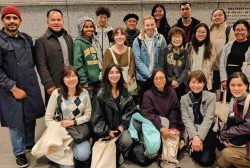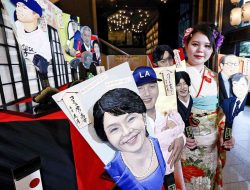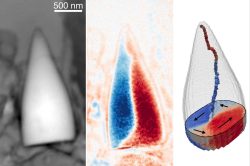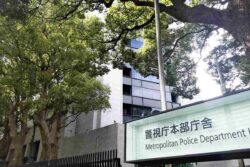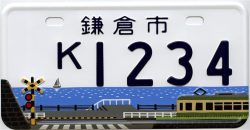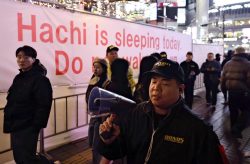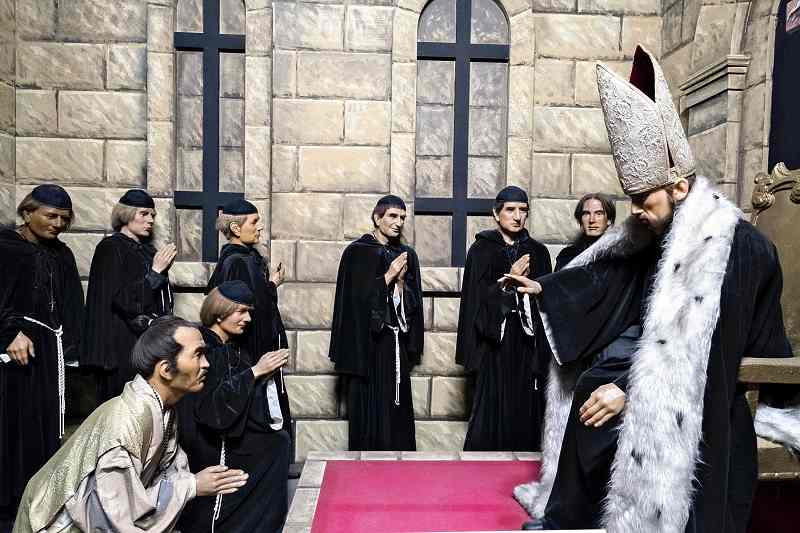
Hasekura Tsunenaga is received for an audience with Pope Paul V. in this reproduction, which is on display at the Michinoku Date Masamune Rekishikan historic museum in Matsushima, Miyagi Prefecture.
17:16 JST, March 16, 2021
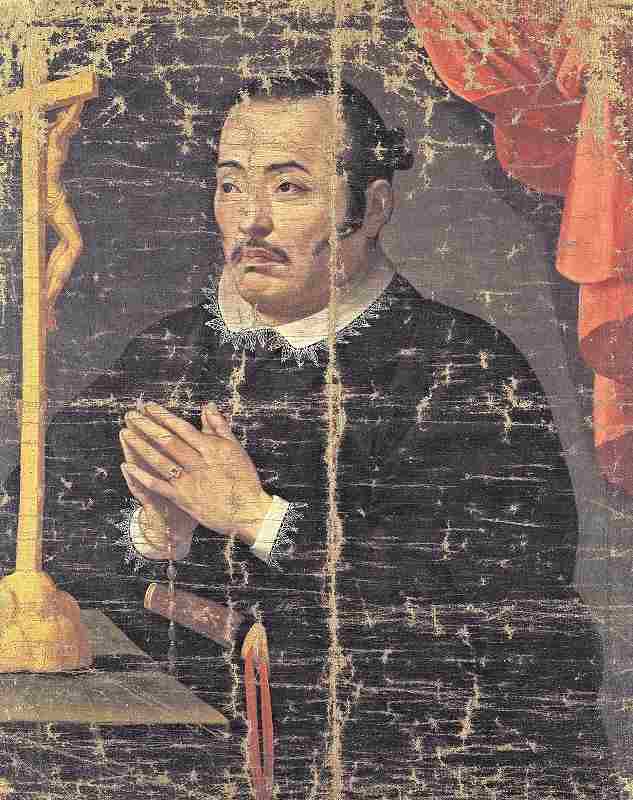
“Portrait of Hasekura Tsunenaga,” painted in 1615. The oil painting on hemp canvas measures 80.8 x 64.5 centimeters and is listed on the Memory of the World by UNESCO. This national treasure from the “Materials related to the Keicho-era Mission to Europe” is in the possession of the Sendai City Museum. This portrait is said to have been painted by French artist Claude Deruet by order of the Roman Curia.
In the early Edo period, Hasekura Rokuemon Tsunenaga, a samurai and retainer of Sendai daimyo Date Masamune, traveled to Spain and Rome at the behest of Masamune, who wanted trade with Mexico, which was then a territory of Spain.
The Keicho Embassy that Tsunenaga led as ambassador departed Japan in 1613 (the 18th year of the Keicho era). Portraits, including his own that Tsunenaga brought back to Japan seven years later are currently in the possession of the Sendai City Museum as “Materials related to the Keicho-era Mission to Europe,” a national treasure.
Tsunenaga is depicted in the portrait — said to have been painted in Rome in 1615 — praying with his whole heart to a statuette of Jesus Christ on the cross.
The voyage across the Pacific and Atlantic oceans was fraught with difficulty and the trade negotiations did not succeed. But the famous Samurai Ambassador, whose mission took him from Japan to Europe, “left a strong impression upon the local people as a prudent and noble person,” said Toru Sasaki, a 47-year-old curator of the city museum.
Included in the related materials are a portrait of Pope Paul V, with whom Tsunenaga was granted an audience in Rome in 1615, sacred paintings and artifacts.
Let us trace the narratives behind the precious materials that were handed down to the present day, following those years when Christianity was prohibited during the Edo period.
In Spain, where Tsunenaga went before heading to Rome, he handed over a letter from Masamune to Spanish King Philip III in 1615 seeking trade, and was later baptized in Madrid in the presence of the king. Tsunenaga was given the Christian name Felipe Francisco Hasekura, in honor of the king and a saint.
Back then, the Roman Catholic Church instructed orders such as the Franciscans to dispatch missionaries to various parts of the world to propagate the faith.
Masamune, upon advice from Franciscan padre Luis Sotelo, sent the Keicho diplomatic mission to Europe, with Sotelo accompanying it. In his letter to King Philip, Masamune asked for the dispatch of missionaries to the feudal domain of Sendai. The request was intended to please the king, who was zealous for propagation. The audience with Pope Paul V was also meant to ask him to intermediate between Japan and Spain. But the fact that the Tokugawa shogunate’s stance of banning Christianity was growing had already been known to Europe during the delegation’s voyage.
Despite this, Tsunenaga was able to gain an audience with the Spanish king and the pope, primarily because of his character, to which both were said to give credit. The certificate of civil rights of Rome, which is included in the materials, stated that the city council of Rome gave Tsunenaga the honorary title of Roman noble and citizen.
Tsunenaga returned to Sendai in 1620 but died shortly afterward. A rumor floated that Tsunenaga had renounced the Christian faith. But according to a letter written by the padre Sotelo in 1624 in Kyushu, Tsunenaga died a pious Christian, while leaving a will to his children that they should propagate Christianity within the fief and protect missionaries. Backing this up was the revelation in 1640 that Tsunenaga’s son Tsuneyori had sheltered a missionary, which led to the Sendai domain confiscating Tsunenaga’s portrait, a painting of the Blessed Mary, and other artifacts.
Tsunenaga’s portrait is scarred with a vertical line, meaning that it was probably crudely folded after it was confiscated.
Upon seeing this, I could sense the spirit of a samurai who devoted himself entirely to his faith despite the adversity.

Tsunetaka Hasekura, center, is seen during the 2014 reenactment of Hasekura Tsunenaga’s 1614 landing at Coria del Rio, Spain. On his left is Jose Japon Sevilla.
Proud legacy in a surname
After reaching Spain in 1614, Tsunenaga’s delegation traveled upstream from an estuary of the Guadalquivir River in the south. Back then, ships would let off passengers and cargoes at Coria del Rio, a town on the way to the major city of Seville.
In this town today, there are about 600 people with the surname Japon or Xapon — both Spanish renderings of “Japan.” They have taken pride in handing down over generations a folktale that they are the descendants of “those samurai who were members of the embassy and stayed behind in the town.”
The biggest reasons for their pride in being samurai descendants stem from praises of grace and discreetness, and such descriptions that Tsunenaga “had been trusted by people and attracted people,” all of which were left behind by those who came in contact with him in various parts of Europe.
People with the surname Japon also live in Coria del Rio’s neighboring towns and cities. Jose Japon Sevilla, 61, who lives in Seville, used to be a referee in Spanish soccer’s premier division. Because he was strict about foul play, he was popularly called the “samurai referee.”
Sevilla, as well as others who have carried the surname Japon, researched the life of Tsunenaga for decades.
He said, “I was fascinated by such a way of living led by Tsunenaga, who endured a sea voyage fraught with extreme difficulty, and returned to his lord, Date Masamune, solemnly, even though the trade negotiations failed.”
Affection felt everywhere in town
Tsunenaga’s delegation began its voyage in 1613 from a port in present-day Ishinomaki, Miyagi Prefecture, aboard the Sant Juan Bautista, a galleon built by the Sendai clan.
In an event held in 2013 to commemorate the 400th anniversary of diplomatic relations between Japan and Spain, the Emperor, then the crown prince, planted a cherry tree in Coria del Rio, and met with the local people, including those with the surname Japon.
In the following year, the embassy’s voyage sailing upstream on the Guadalquivir River was reenacted. Tsunetaka Hasekura, 74, a 13th-generation descendant of Tsunenaga from Sendai, took part in the reenactment, accompanied by the referee Sevilla, and landed at Coria del Rio. At the request of the local people, Tsunetaka narrated the story of Tsunenaga following his return to Japan as a Catholic.
Tsunenaga’s son, Tsuneyori, who succeeded as head of the Hasekura family, was decapitated in 1640 because he sheltered missionaries. And as his younger brother and servants were convicted as Catholics, the family’s privileges were abolished by the Sendai clan. Yet the clan later allowed a son of Tsuneyori to revive the Hasekura family.
Although Masamune had been dead since 1636, Tsunetaka reckons that “lying behind the revival of the family could be the fief’s consideration of Masamune’s remorse, in that he had given a lot of trouble to Tsunenaga, whom Masamune had put devout faith in.”
On a riverbank in Coria del Rio, a bronze statue of Tsunenaga stands. Katsuhiko Imae, 60, who has been working as a tourist guide based in Seville, said, “As there is a torii [archway of a Shinto shrine] and Japanese signs in a park, and Japanese signboards of stores, I can feel the affection toward Japan here and there in the town.”
This is a town where I hope many Japanese will visit when the coronavirus crisis is brought under control.
"Society" POPULAR ARTICLE
-

Tokyo’s Off Limit Areas Becoming Popular for Tours
-

Fire Damages 170 Buildings in Oita, Western Japan
-

Tatsuya Nakadai, Japanese Actor, Dies at 92; Appeared in Films Including “The Human Condition” and “Ran” (UPDATE 1)
-

M5.7 Earthquake Hits Japan’s Kumamoto Pref., Measuring Upper 5 Intensity, No Tsunami Expected
-

No Easy Fix for Tokyo’s Soaring Real Estate Prices
JN ACCESS RANKING
-

Govt Plans to Urge Municipalities to Help Residents Cope with Rising Prices
-

Japan Resumes Scallop Exports to China
-

Japan Prime Minister Takaichi Vows to Have Country Exit Deflation, Closely Monitor Economic Indicators
-

Japan to Charge Foreigners More for Residence Permits, Looking to Align with Western Countries
-

Japan GDP Down Annualized 1.8% in July-Sept.



